In the Early 1960s Pop Art Was Designed to Represent Reality in Terms of
"Pop Art" is a name that reads similar a contradiction. Art is often lauded equally high-minded and original. Pop is largely disdained every bit lowbrow and repetitive. But in many ways, the name encapsulates what makes Pop Fine art design then compelling: it revels in irony and combines what shouldn't be combined.

Of course, Popular Art design owes its greatness to more than a catchy name. It is an incredibly vibrant, derisive and diverse way whose appeal has endured for decades, no doubt for its office in wresting fine art from the hands elite to those of the masses. To help you get your own hands on this artful, nosotros're going to walk through the roots of Pop Art and the many ways information technology is still being adjusted to this day.
What is Popular Art design?
—

Pop Art pattern is a fine art movement that reigned in the mid 1950s and 60s that largely focused on representations of popular, American pop culture iconography. These representations often ranged from literal, such as Roy Lichtenstien's reproductions of actual comic volume panels, to stylized, such as Richard Hamilton'southward mag collages. In contrast to artwork that highlighted the item hand of an artist, Popular Fine art routinely mimicked the impersonal and machine-driven graphics of commercial products.
Like all fine art, what defines something as Popular Fine art is not ever straightforward—it depends on the particular obsessions and sensibilities that inevitably vary from artist to creative person. All the same, most Pop Fine art does share a few common elements:
- Subject matter featuring popular Americana such equally celebrities, advertisements, shopping catalogues and comic books
- Mass production techniques such as halftone printing
- Excessive repetition
- Prototype reproductions with substituted colors
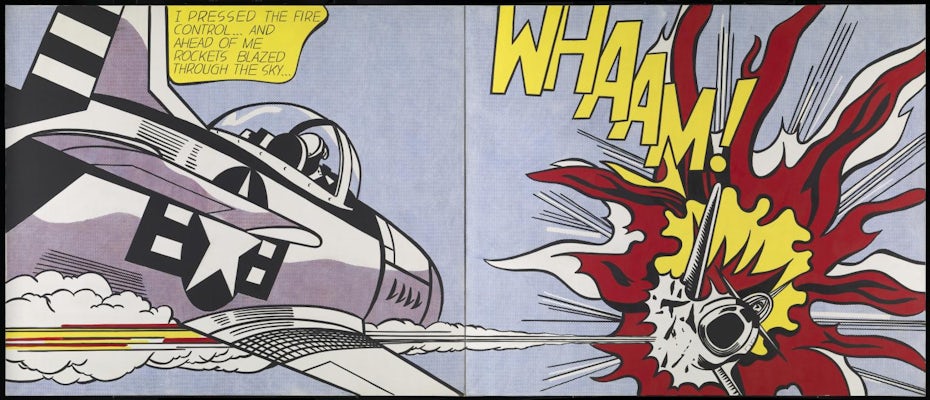
While all of this describes the visual features of Pop Art, it fails to truly explain what Pop Fine art meant to both its artists and its devotees. How did a fashion that frequently reproduced the same, over-distributed commercial images manage to have such a lasting affect? In order to empathize that, nosotros'll have to wait into the historical context of the time, place and the people involved.
A brief history of Popular Fine art
—
The roots of Popular Fine art
Like so many creative revolutions, Pop Art was ofttimes decried with some variation of This isn't art! To some extent, these critics had a point: reproductions of ordinarily bachelor images certainly was not what fine art had been up until that bespeak.
But at the same time, American art had experienced a relatively recent menstruation of realism, or naturalism. In this move, artists reclaimed the subject field matter of their art from religion or bourgeois portraits to scenes (frequently gritty) of ordinary people in order to show American life as information technology truly was. This was assorted by modernist European movements such equally Cubism, Dadaism, and Surrealism, much of which was greeted by Americans in the 1913 Arsenal Bear witness with consternation and horror—Theodore Roosevelt himself famously declaring of French artist Marcel Duchamp, "He is nuts and his imagination has gone wild!" Merely all of these movements were vital precursors to Pop Art for challenging how fine art was supposed to expect and what it could exist virtually.
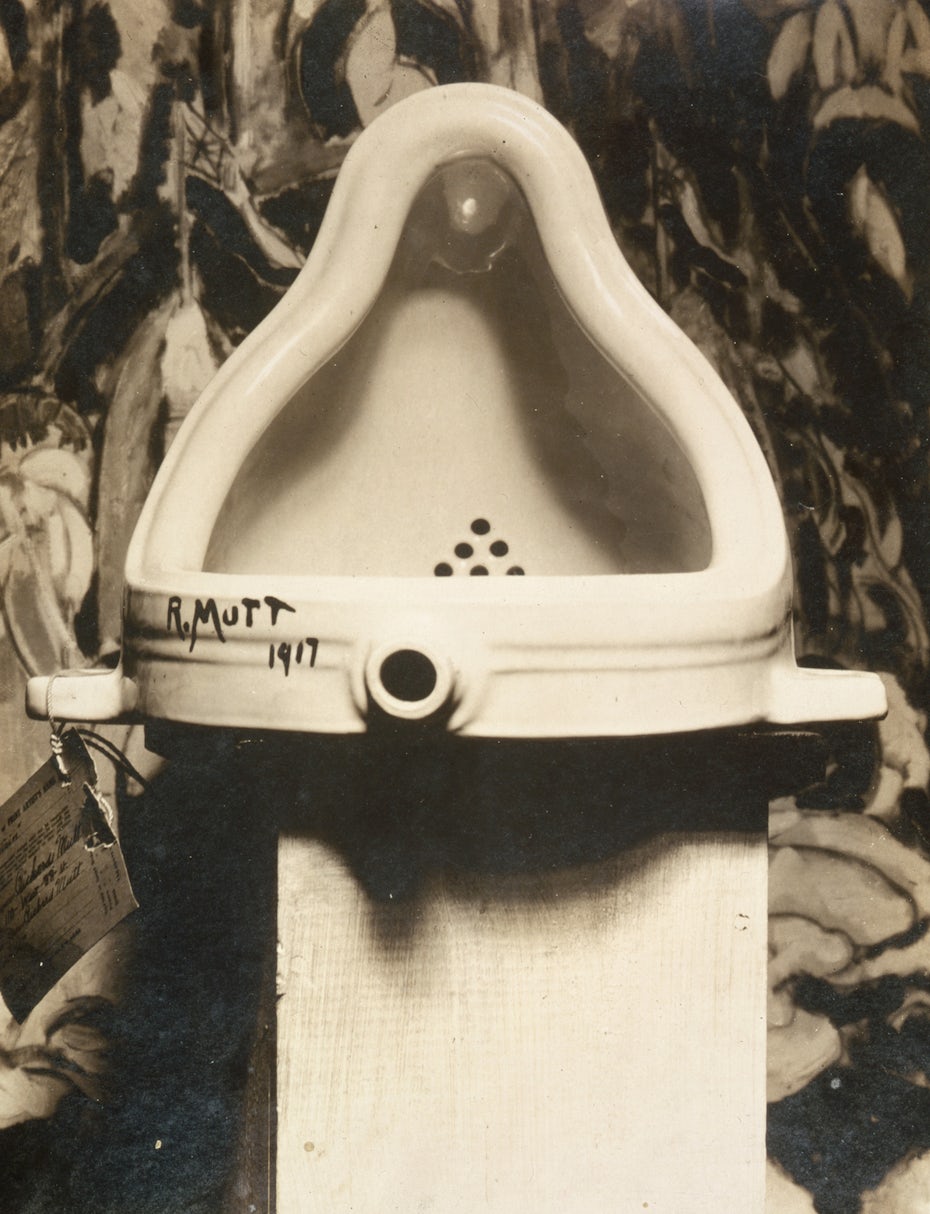
Outside the art globe, American life had changed drastically. Industrialization had introduced mass production and crowded urban centers. Afterwards, the end of Earth War II and the economical nail that followed brought nigh a mass migration to the suburbs, in search of tranquility, residential lives.
At the same time, advertising was ramping upward as a defined industry, helped along past new applied science such as the radio and the television. Practices that emphasized aspirational imagery, slogans and jingles repeated ad nauseam became commonplace.
Many of the images that ads used during this period—backyard family barbecues, housewives in full hair-and-makeup showing off the latest appliance, enjoying a Coke after some good old American baseball—both reflected and molded the ideal suburban life, what has been branded as "The American Dream." As such, the values of American civilization during this menstruation were largely tied to tv, movies and commercialism. These cultural and artistic movements all laid the bedrock for Pop Art design.
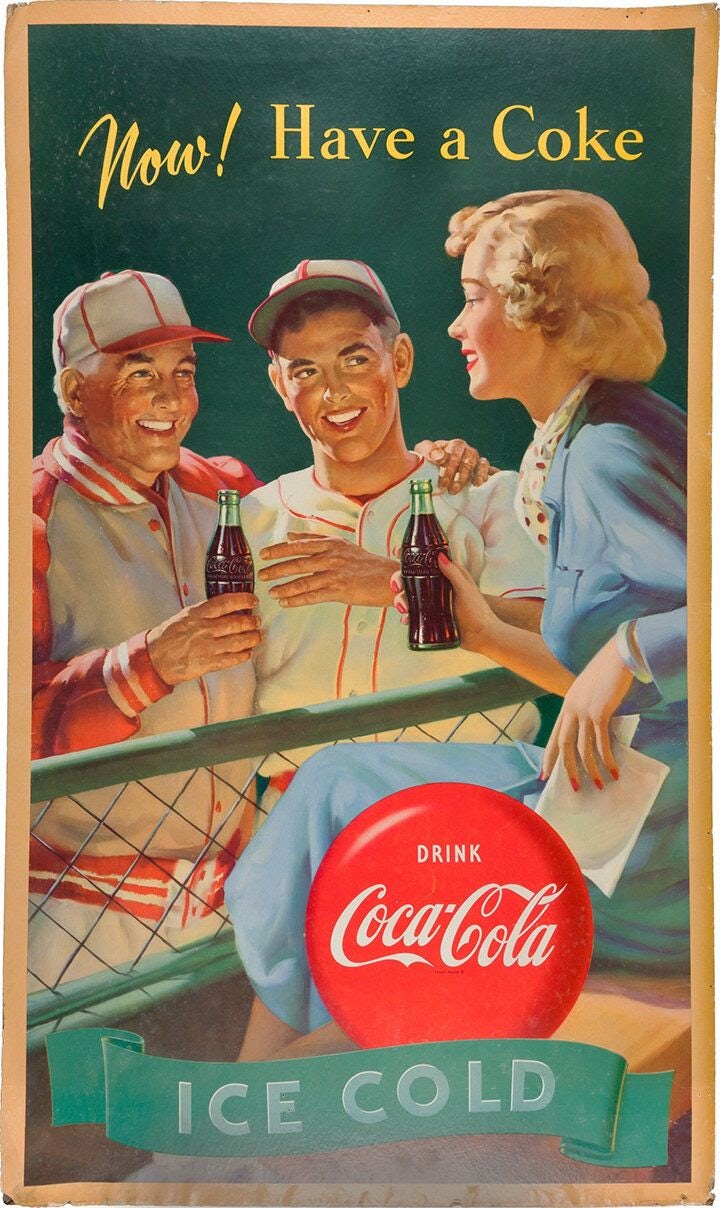
The Pop Art artists
Although American media and consumerism was the subject of Pop Fine art, the term originated in the Great britain in the 1950s. In the European context, Popular Fine art largely served as a reaction to the encroachment of US pop culture through advertizement.

The collages of British artist Peter Blake, for example, often combined US pop culture iconography with those from the UK. His album sleeve for Sgt. Pepper'southward Solitary Hearts Club Band famously features a multitude of cultural icons standing prominently backside the Beatles, from Bob Dylan and Fred Astaire to Shirley Temple and William S. Burroughs.


Meanwhile, Pauline Boty, a founder of the British Pop Art movement, regularly incorporated publicity headshots of male and female celebrities into her paintings, combining them with rose petals and vibrant colors in celebratory sensuality.
Later on on, her work took on a more than critical eye, notably in her 1964 painting It'due south A Human's World I which depicts popular images of famous men as the edifice blocks to government and warfare.
Across the swimming, American artists represented their own relationship with rampant advertising as reflections of both ideals and reality. Like to how Greek classical artists sculpted their mythic heroes and gods equally the epitome of beauty, American media had generated new dazzler standards.

Robert Rauschenberg, one of the earliest American Pop Fine art artists and something of a successor to the "nuts" Dadaist artist Duchamp, created mixed textile collages that incorporated discarded objects into paintings, much similar the buried artifacts that define lost civilizations. One of his most famous works, a painting titled Retroactive II (1963), utilized commercial silk screen techniques and appropriation of famous photos, firmly identifying him with the Popular Art movement.
James Gill is some other Pop Fine art artist who featured images of political figures and electric current events in his fine art merely with a incomparably more critical tone than his contemporaries—The Machines (1965) showing Nixon speaking into microphones whose cables funnel downward into photos of deadly warfare.
Rosalyn Drexler—who boasts pedigree in disciplines ranging from fine art, novel writing and wrestling—similarly constructed her paintings out of disparate collaged images often appropriated from pulp flick posters and painted over them with bold, minimal colors.

Andy Warhol is often recognized as Pop Fine art's star, a celebrity ultimately as iconic as those he depicted, and much of his work did come up to encapsulate what Pop Art was all almost. His famous Campbell's Soup Cans (1962) was reproduced and displayed in rows and columns—an artistic mirror of supermarket stock. His Marylin Diptych (1962) pioneered Pop Fine art silk screening to reproduce portraits of the late Marylin Monroe at the height of her fame in vibrant colors, fading to black-and-white and then nothing.
All in all, Pop Art is both a motility associated with Americana just besides the creative counterculture of the 1960s. Notwithstanding, its legacy has endured through the ages.
It received a particular revival in the 1980s through Keith Haring, whose energetic humanoids emphasized repetition and commercial reproduction in social club to create accessible fine art. In this way, his murals and pop store merchandise received massive fame, all while spreading awareness of problems ranging from apartheid to queer bigotry.
In more than recent times, artists from Takashi Murakami to Banksy have carried the torch of Pop Fine art into the mod age.

Pop Art in contemporary pattern
—
At the stop of the day, Pop Art is a versatile aesthetic that any designer can adapt into their work regardless of which decade they discover themselves in. To empathise how this is done, let's take a look at some contemporary designs that channel Pop Fine art.
Many designers evoke the mode through reference and imitation of classic Popular Art works. Not simply is this the almost straightforward approach, it fits in neatly with Pop Art's ethos of direct cribbing and parody.
Both Digital Man and oink! design, for example, take this approach to draw logo designs as serial of multicolored portraits in homage to Marilyn Diptych, with commercial vector techniques acting as the digital age equivalent of 60s era mass production.
Alebelka and Monsat, meanwhile, use repetition and reproduction to create designs that call to heed Campbell's Soup Cans.
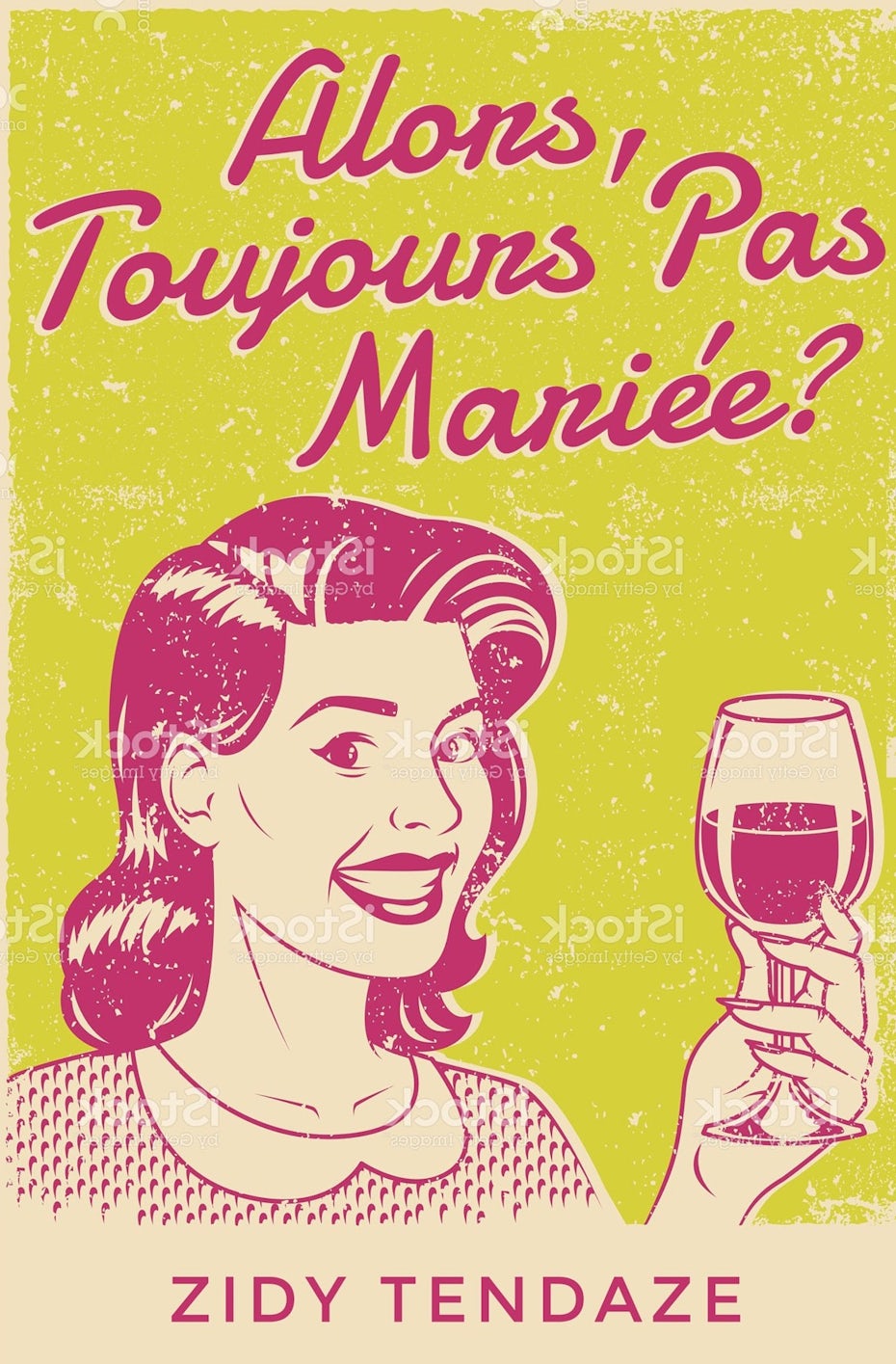
The in a higher place approach works best when the referenced works are well-known, and equally a consequence, it tends to be more than evocative of Warhol in item than Pop Art in general. But in improver to specific works and artists, it is also associated with the 1960s, and aspiring Pop Art artists can cull to hearken dorsum to the aesthetics of this decade. While pop culture has inverse drastically over the years, the specific ideals of vintage advertising are still palpable. If anything, time has just exposed their shallow nature.
Designs in this style showcase (often ironically) 1950s suburban bliss, such as Alice R's book cover. The vintage illustration of a smile woman looks like it was ripped directly from an old mag insert, bated from the stylized color filter. But the accusatory title (translated from French) "So, Y'all're Still not Married?" makes what would otherwise be an innocent smile wait strained.
Vintage superheroes are another recurring element in Pop Art design, particularly for their embodiment of pristine, golden age virtue. Tomie O goes a step further with a packaging blueprint that features non just a superhero simply also vintage type and graphic text reminiscent of old-school shopping catalogue.
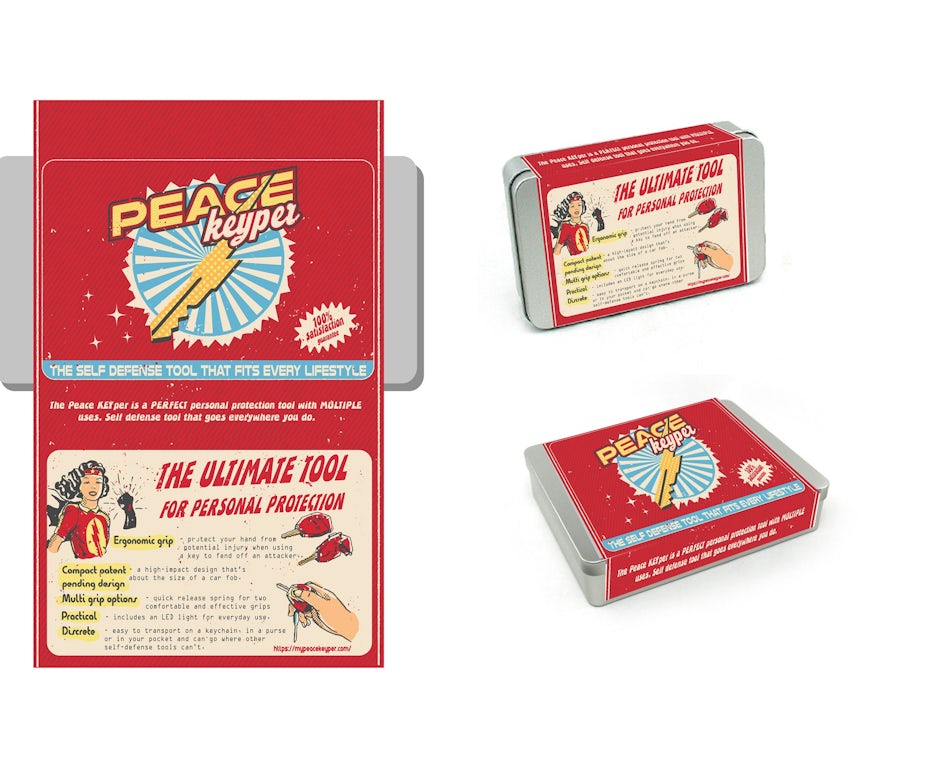
Besides directly popular civilization imagery, many Popular Art artists also incorporated classic techniques of mass production into their work, especially those of halftone dots. These likewise happen to be reminiscent of polka dots used in the work of famed Popular Art artists like Yayoi Kusama. The slap-up thing most halftones is they can infuse designs with a Popular Art sensibility in a subtle way, making them amenable to any number of design contexts from packaging to logo design.
Make your design popular
—
Popular Art blueprint is a dynamic, blithesome art style that has managed to stick around for one-half a century, which is not surprising given the powerful impression it conveys.
It appeals to common sensibilities with familiar images and techniques. At the same time, it shows usa what nosotros value by reflecting our ads, our idols and even our garbage right back at us. For all these reasons, if yous find your designs are too ofttimes uninspired, consider for once letting them go pop.
Want to add some Pop Art into your side by side design?
Work with our creative community of designers to make it happen.
Source: https://99designs.com/blog/design-history-movements/pop-art-design/
0 Response to "In the Early 1960s Pop Art Was Designed to Represent Reality in Terms of"
Post a Comment